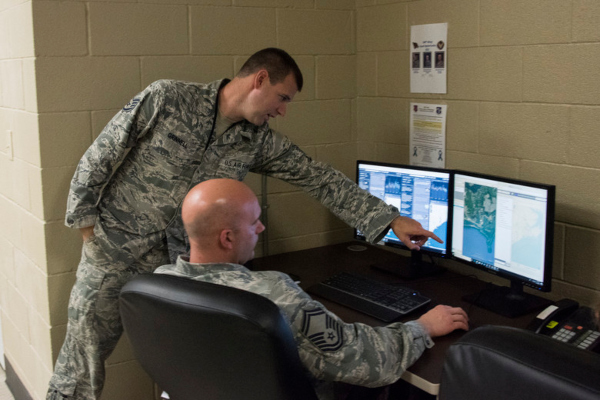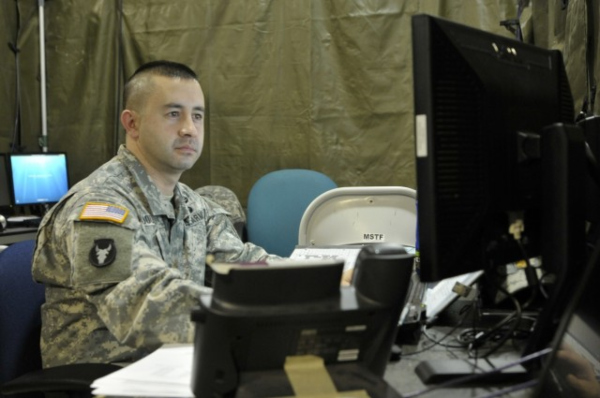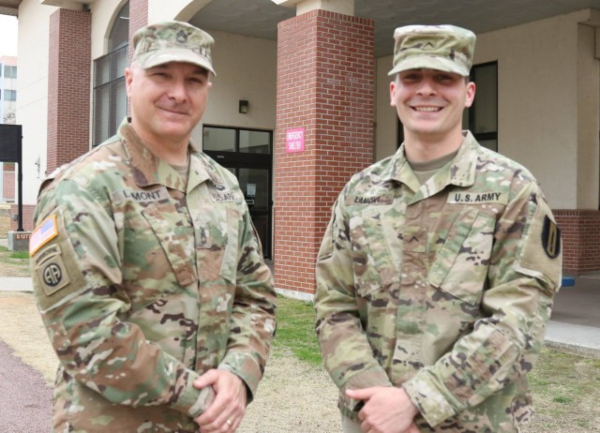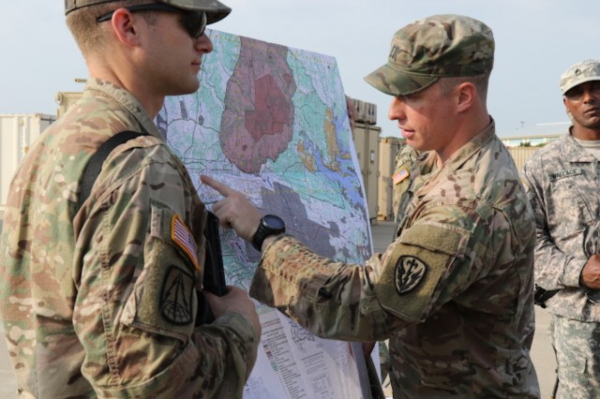An Army Geospatial Intelligence Imagery Analyst (MOS 35G) is part of the military intelligence (MI) branch.
Geospatial Intelligence Imagery Analysts deal with aerial and overhead imagery, which is developed by photographs and other electronic devices.
The information that Army MOS 35G is capable of discovering from aerial photographs is instrumental in gaining an advantage over enemy forces.
Learn more job details about Army Geospatial Intelligence Imagery Analyst (MOS 35G) including required training and pay.
Related Article – Army Signals Collection Analyst (MOS 35S): Career Details
Education, Qualifications, and Training

The U.S. Army outlines educational and training requirements for all personnel.
Every service member has a Military Occupational Specialty (MOS) in the Army that determines qualifications and requirements.
Education
The Army requires new recruits to have a high school diploma or GED equivalent.
Additionally, recruits must complete the Armed Services Vocational Aptitude Battery (ASVAB).
The ASVAB determines which Military Occupational Specialties you qualify for based on test performance.
Army Geospatial Intelligence Imagery Analysts (MOS 35G) are required to have a minimum ASVAB test score of Skilled Technical (ST): 101.
Qualifications
Geospatial Intelligence Imagery Analysts need to be citizens of the United States, with an additional requirement of not having immediate family members who are not U.S. citizens as well.
Army MOS 35G deals with highly classified and sensitive information, which makes discretion of the utmost importance.
Geospatial Intelligence Imagery Analysts (MOS 35G) need to receive Top Secret security clearance from the Department of Defense.
The background check for a Top Secret security clearance is incredibly thorough.
The D.O.D. examines your past, including personal finances, criminal records, and drug/alcohol activity.
Therefore, you need a record free of any convictions (besides minor traffic violations) as well as no previous convictions by court-martial.
Army Intelligence Military Occupational Specialties do not allow anyone that has ever served in the U.S. Peace Corps to join the division.
The reason is that the U.S. government wishes to separate humanitarian work from intelligence duties to remain free of suspicion and avoid targeting aid workers as potential spies.
The rigorous eligibility requirements also maintain that your spouse or immediate family members cannot reside in a country where “physical or mental coercion is a common practice.”
Finally, prospective MOS 35G Geospatial Intelligence Imagery Analysts cannot have a commercial or vested interest in another country.
A recruiter can help clarify any potential eligibility conflicts.
Training
Prospective Army Geospatial Intelligence Imagery Analysts spend the first 10 weeks of training at boot camp, even though it’s a non-combat MOS.
After Basic Combat Training (BCT), recruits progress to Advanced Individual Training (AIT) for MOS 35G.
Advanced Individual Training lasts 22 weeks for Army 35G MOS.
AIT training takes place at Fort Huachuca in Arizona.
Your training includes learning how to plan overhead and aerial imagery collection and using computer systems.
Army MOS 35G recruits receive instruction on preparing maps, charts, and reports for Geospatial-Intelligence.
Analysis of fixed/moving target indicators and other geospatial data gathering is emphasized during classroom instruction.
What does an Army Geospatial Intelligence Imagery Analyst (MOS 35G) Do?

An Army Geospatial Intelligence Imagery Analyst (MOS 35G) is vital to the intelligence community of the military branch.
Geospatial Intelligence Imagery Analysts provide Army personnel with critical information about enemy forces, combat operations support, and potential battle areas.
Army MOS 35G analyzes images to design plans for everything from combat operations to disaster relief.
Geospatial Intelligence Imagery Analysts rely on aerial imagery, full-motion video, geospatial data, and other electronic monitoring to gather intelligence.
Aerial and overhead imagery can provide a wealth of knowledge about enemy forces.
It may assist with determining target coordinates, identify enemy positions, conduct battle damage assessments, and other crucial reports to the U.S. Army.
However, not all information collected by Army MOS 35G Intelligence Analysts is used for enemy forces.
In some cases, Geospatial Intelligence Imagery Analysts also assist with recovery from natural disasters.
Army Military Intelligence (MI) Branch
The Military Intelligence (MI) division of the U.S. Army has several important job specialties.
Along with MOS 35G Geospatial Intelligence Imagery Analyst, there are three other primary intelligence Military Occupational Specialties:
- All-Source Intelligence Officer (MOS 35D)
- Human Intelligence Analyst (MOS 35F)
- Counterintelligence Officer (MOS 35E)
- Geospatial Signals Intelligence Analyst (MOS 35G)
Those seeking to join MOS 35 Job Field in the U.S. Army should have an interest in information gathering and interpreting that information.
An interest in reading maps and charts also helps with MOS 35G.
The same is true of having the ability to think, speak, and write clearly.
Related Article – Army Human Intelligence Collector (MOS 35M): Career Details
What does an Army Geospatial Intelligence Imagery Analyst (MOS 35G) make?

An Army Geospatial Intelligence Imagery Analyst (MOS 35G) receives pay based on military rank, not MOS.
The U.S. Army decides to treat all Military Occupational Specialties equal by not compensating one military job more than another one.
Therefore, your pay in the Army is based on military rank and years of service.
| Insignia | Pay Grade | Rank | Abbreviation | Minimum Monthly Pay |
|---|---|---|---|---|
| E-1 +4 months | Private | PVT | $1,917.60 | |
| E-2 | Private Second Class | PV2 | $2,149.20 | |
| E-3 | Private First Class | PFC | $2,259.90 | |
| E-4 | Specialist | SPC | $2,503.50 | |
| E-4 | Corporal | CPL | $2,503.50 | |
| E-5 | Sergeant | SGT | $2,730.30 | |
| E-6 | Staff Sergeant | SSG | $2,980.50 | |
| E-7 | Sergeant First Class | SFC | $3,445.80 | |
| E-8 | Master Sergeant | MSG | $4,957.20 | |
| E-8 | First Sergeant | 1SG | $4,957.20 | |
| E-9 | Sergeant Major | SGM | $6,055.50 | |
| E-9 | Command Sergeant Major | CSM | $6,055.50 | |
| E-9 | Sergeant Major of the Army | SMA | $6,055.50 |
Benefits
Additionally, the Army provides a really good benefits package:
- Vacation Time
- Special Pay
- Medical Insurance
- Retirement
- Affordable Life Insurance
- Education: Soldiers can earn full-tuition, merit-based scholarships, allowances for books and fees, plus an annual stipend for living expenses.
- Housing: Allowances for living expenses, utilities, and maintenance.
- Food: Allowance for the on-base dining hall and access to tax-free department and grocery stores.
Job Reviews
You can find relevant job reviews for Army MOS 35G on websites like Indeed.com.

Serving the U.S. Army in intelligence gathering is a very rewarding opportunity yet many personnel fail to qualify based on the rigorous qualifications of MOS 35G.

A military lifestyle suits many individuals that need some form of direction and purpose after graduating from high school or college.

Related Article – Army Cryptologic Linguist (MOS 35P): Career Details
Civilian Job Opportunities
Geospatial Intelligence Imagery Analysts gather most of their information specifically for the military.
However, the research, interpretation, and analysis skills you acquire will serve you well in a variety of industries.
Government agencies like the CIA prefer hiring former military with a background in research and data analysis.
Some former MOS 35G Intelligence Analysts prefer to enter the private sector after leaving the military and find work as a surveyor or mapping technician.
Summary
Geospatial Intelligence Imagery Analysts (MOS 35G) are important to the intelligence community of the U.S. Army.
The information they collect from aerial and overhead imagery helps gather sensitive information on enemy forces as well as provides relief following a natural disaster.
Resources:
- 68 Series MOS: A List of Medical Field Jobs in the Army - June 19, 2024
- 15 Series MOS: US Army Aviation Jobs - June 19, 2024
- 11 General Orders For Each Military Branch - June 19, 2024
General FAQ
What does Army Geospatial Intelligence do?
An Army Geospatial Intelligence Imagery Analyst works with aerial imagery from photographs and electronic surveillance to gain an advantage over enemy forces.
What ASVAB scores do you need for Army Geospatial Intelligence?
To enter into Army Geospatial Intelligence as a MOS 35G, you’ll need a minimum score of 101 on the Skilled Technical portion of the Armed Forces Vocational Aptitude Battery.
How long is AIT for Army MOS 35G?
After 10 weeks in Basic Combat Training, Advanced Individual Training for Army Geospatial Intelligence Analyst is 22 weeks long and is conducted at Fort Huachuca in Arizona.
How much do Army imagery analysts make?
Like all Army positions, Army Geospatial Intelligence Analysts are paid according to their rank and time in service. A new recruit with less than two years in can currently expect a base pay of about $1,700 per month.
What can an Army Geospatial Intelligence Imagery Analyst do after service?
While the skills involved in Geospatial Intelligence are very specific to the military, other government agencies, such as the CIA, hire former military with an intelligence background.

